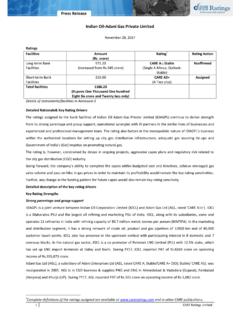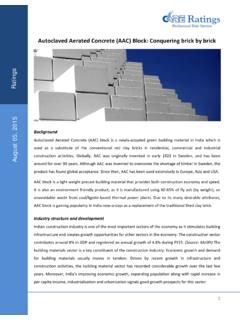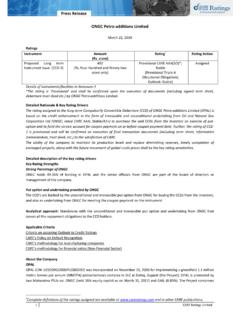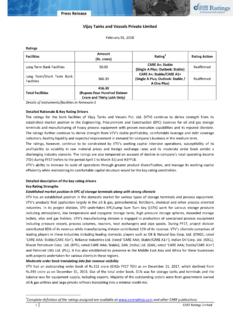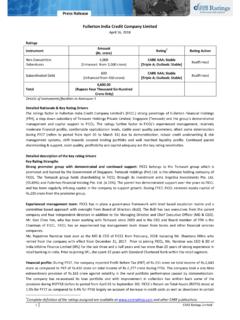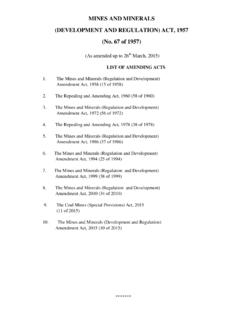Transcription of August 18, 2017 I Industry Research Aluminium …
1 August 18, 2017 I Industry Research Aluminium Industry : Overview The Silver Knight of the Aluminium is one of the lightest metals in the world and as a result Economy it is used widely in the production of multiple products. This metal has a shiny silver colour and it is malleable meaning it can be bend Contact: without breaking. In nature, Aluminium is found in an ore called Madan Sabnavis bauxite. Bauxite is the basic raw material in the Aluminium Chief Economist manufacturing process. Bauxite is converted into alumina in 91-022- 6754 3489 alumina refineries. Aluminium is the 3rd most available element present in the earth's Urvisha H Jagasheth crust and the 2nd most used metal after steel. According to USGS. Research Analyst India ranks 9th in terms of bauxite reserves in the world. 91-22-6754 3492. The Aluminium production process can be divided into upstream and Guided by: downstream activities. The upstream process involves mining and Hitesh Avachat refining activities, while downstream process involves smelting and casting & fabricating.
2 Aluminium downstream fabricated products include rods, sheets, extrusions and foils. Mradul Mishra (Media Contact). Globally, Aluminium is produced by two different methods, the 91-022-6754 3515. primary production process which involves the conversion of ores to Aluminium and the other is secondary production (recycling) where the Aluminium scrap is recycled to produce Aluminium again. In India primary Aluminium Industry is dominated by 3 companies: Hindalco and Vedanta which are privately owned and NALCO which is a public sector undertaking having a Navratna status. Process of manufacturing Aluminium Aluminium production first begins with the mining of bauxite and ends with liquid Aluminium getting converted into various products. The Aluminium production process can be broken down into three stages; first bauxites, which contain Aluminium , are extracted from the ground. Second, bauxites are processed into alumina or Aluminium oxide, and finally pure Aluminium is produced. Disclaimer: This report is prepared by CARE Ratings Ltd.
3 CARE Ratings has taken utmost care to ensure accuracy and The Aluminium process begins with the mining of bauxite. Bauxite objectivity while developing this report based on information available in public domain. However, neither consists of 45-60% Aluminium oxide, along with various impurities the accuracy nor completeness of information contained in such as sand, iron, and other metals. Approximately it takes 3-4kgs this report is guaranteed. CARE Ratings is not responsible for any errors or omissions in analysis/inferences/views or of bauxite to produce 1kgs of alumina and it takes 2kgs of alumina for results obtained from the use of information contained to produce 1kg of Aluminium . The process of Bauxite refining in this report and especially states that CARE Ratings has no financial liability whatsoever to the user of this report involves the use of Bayer Process and once the bauxite is converted to alumina, further on the process of reduction of alumina to Aluminium is called Hall- Heroult process.
4 Industry Research I Aluminium Industry . Chart 1: Structure of the Aluminium Industry Aluminium Industry Primary Producers Secondary Producers Aluminium Ingots Semi Fabrication New Scrap Finished Products Output Rolling Extrusions Casting and Forgings Drawings Source: CARE Research Bauxite, Alumina and Power constitute the major components of the total operating costs. Other raw materials used in the manufacturing process included are calcined petroleum coke, caustic soda, Aluminium fluoride, fuel/oil and steam/. anthracite coal. The average electricity consumption for the production of 1 tonne of Aluminium is about 15,000 kwh, whereas for alumina the same is about 260 kwh per tonne. Since it takes 2 tonnes of alumina to manufacture 1 tonne of Aluminium , of the 15,000 kwh, about 500kwh is consumed during the process of refining the bauxite to alumina, while the rest is consumed in the electrolysis process. 2. Industry Research I Aluminium Industry . Chart 2: Steps to Manufacture Alumina: Bayer Process Bauxite is crushed, dried and ground in special mills where it is mixed with a small amount of water.
5 This process produces a thick paste that is collected in special Crushing containers and heated with steam to remove most of the silicon present in bauxites. The ore is loaded into autoclaves and treated with lime- caustic soda. Aluminium oxide appears in the resulting slurry while all the Digestion admixtures settle to the bottom as red mud. The sodium aluminate solution is stirred in precipatiors for several days , eventually pure alumina settle in the bottom Precipitation Refined Alumina is then passed through the smelters to get transformed to Aluminium . Manufacturers of Aluminium are located near cheap and abundant sources of power as power is one of the largest cost components in manufacturing, as production of Aluminium requires electrolysis. In India, the Aluminium manufacturing companies have their own captive power plants which make the cost of production cheaper vis-a-vis to using commercial power. Chart 3: Steps to Manufacture Aluminium : Hall- Heroult Process. Alumina is poured into special reduction cells with molten cryolite at 950C.
6 Electric currents are then induced in the mixture. This current breaks the Electrolytic bond between the Aluminium and oxygen atoms resulting in liquid reduction Aluminium settling at the bottom of the reduction cell. Primary Alumium is cast into ignots and shipped to customers or used in the production for Aluminium alloys for various purposes. Casting Secondary production of Aluminium involves recycling of the Aluminium . Aluminium does not lose any of its properties when it gets recycled. The added benefit when Aluminium gets recycled is that it consumes only 5% of the energy needed to make the same amount of primary Aluminium . In addition, recycling Aluminium significantly reduces the negative environmental impact of ever-expanding landfills. 3. Industry Research I Aluminium Industry . Bauxite Bauxite contains alumina in three different forms: Gibbbsitic, Boehmit and Monohydrate. All three types of bauxite are soluble in caustic soda but the treatment of boehmite and monohydrate is more expensive vis- -vis than the treatment of gibbsite.
7 Chart 4: World Bauxite Mine Production for CY 2016. 2% 2% 5%. 2%. 3%. 31%. 7%. 10%. 13%. 25%. Australia China Brazil India Guinea Jamaica Russia Kazakhstan Saudi Arabia Other countries Source: United States Geological Survey (USGS) minerals commodity handbook, 2017. India has 593 million tonnes of bauxite reserves and is naturally endowed with large deposits of gibbsitic bauxite. According to Indian Bureau of Mines there are reported 152 mines of which 134 operate in the private sector and 18 mines fall under the public sector. Odisha ranks 1st in mine production followed by Gujarat, Jharkhand and Maharashtra. The abundant reserves of bauxite have made India a net exporter of bauxite. Bauxite is primarily used for the production of alumina, other than that it is also used in refractories, abrasives, chemicals, aluminous cements, and miscellaneous products like proppants. 4. Industry Research I Aluminium Industry . Chart 5: Production Consumption of Bauxite (mn tonnes) Chart 6: Import- Export trends of Aluminium ore (mn tonnes).
8 2012-13 2013-14 2014-15 2015-16 2016-17 (P) 2012-13 2013-14 2014-15 2015-16 2016-17. Production Apparent Consumption* Exports Imports Source: Indian Bureau of Mines Source: Indian Bureau of Mines, DGFT. *Apparent Consumption= Production + Imports -Exports Production of bauxite is growing at a healthy rate of CAGR from FY 2012-13 to FY 2016-17. As India has bountiful bauxite reserves and mining potential, there is a constant rise in the production and mining of bauxite. On the other hand apparent consumption is growing at a CAGR of from FY 2012-13 to FY 2016-17. Till FY 2015-16 India was consuming around 75%-80% of the bauxites produced while the rest of the commodity was being exported. Now due to the rise in the demand of Aluminium in the domestic markets there has been a sudden drop in the exports in FY 2016-17. India exports bauxites to China, Nepal, Saudi Arabia, France, Japan, Slovenia, USA, UK, Oman, Italy and Kuwait. China is the main importer of bauxites from India, almost to an extend of 90% of the total bauxite exports.
9 Imports are quiet negligible in comparison to the exports but whatever little India imports its' from Guinea and Brazil. Alumina Once the bauxite passes through the Bayer process of manufacturing, the finished product is alumina. Alumina is processed in the refinery plants. Metallurgical alumina is used for the manufacturing of Aluminium . Chemical alumina and hydrates are used in range of industries including water treatment, fillers in cables and plastics, refractories and ceramics, glass among others. Smelter-grade alumina accounts for 90% of all alumina produced; it is transported to Aluminium plants, where it is electrolyzed into Aluminium metal. 5. Industry Research I Aluminium Industry . Chart 7: World Alumina Refinery Production for CY 2016. 1% 10%. 2%. 2%. 2%. 2%. 5%. 49%. 9%. 18%. China Australia Brazil India Russia United States Ireland Jamaica Saudi Arabia Other countries Source: USGS. According to the recent USGS report, India ranks 4th in terms of production of Alumina and India also produce 5% of the world alumina.
10 China leads in terms of alumina production. Domestic Alumina plants are owned by the dominant three players of the Aluminium Industry of the country. Chart 8: Alumina Production- Consumption (mn tonnes) Chart 9: Export- Import Trends of Alumina (mn tonnes). 2012-13 2013-14 2014-15 2015-16 2016-17 2012-13 2013-14 2014-15 2015-16 2016-17. Total Alumina Production Apparent Consumption Exports Imports Source: Company Annual Reports (Hindalco, Vedanta, and NALCO) Source: DGFT. Domestic Alumina production is increasing at a growth rate of CAGR from FY 2012-13 to FY 2016-17. In terms of production there has been an increase y-o-y from FY 2015-16 to FY 2016-17. Most of the alumina produced is used for domestic consumption by the respective companies which manufacture it, for the manufacturing of Aluminium metal. 6. Industry Research I Aluminium Industry . The surplus alumina is exported. Consumption of alumina on the other hand is growing at a growth rate of CAGR FY. 2012-13 onwards. There has been a y-o-y increase in from FY 2015-16 to FY 2016-17 of alumina consumption.

